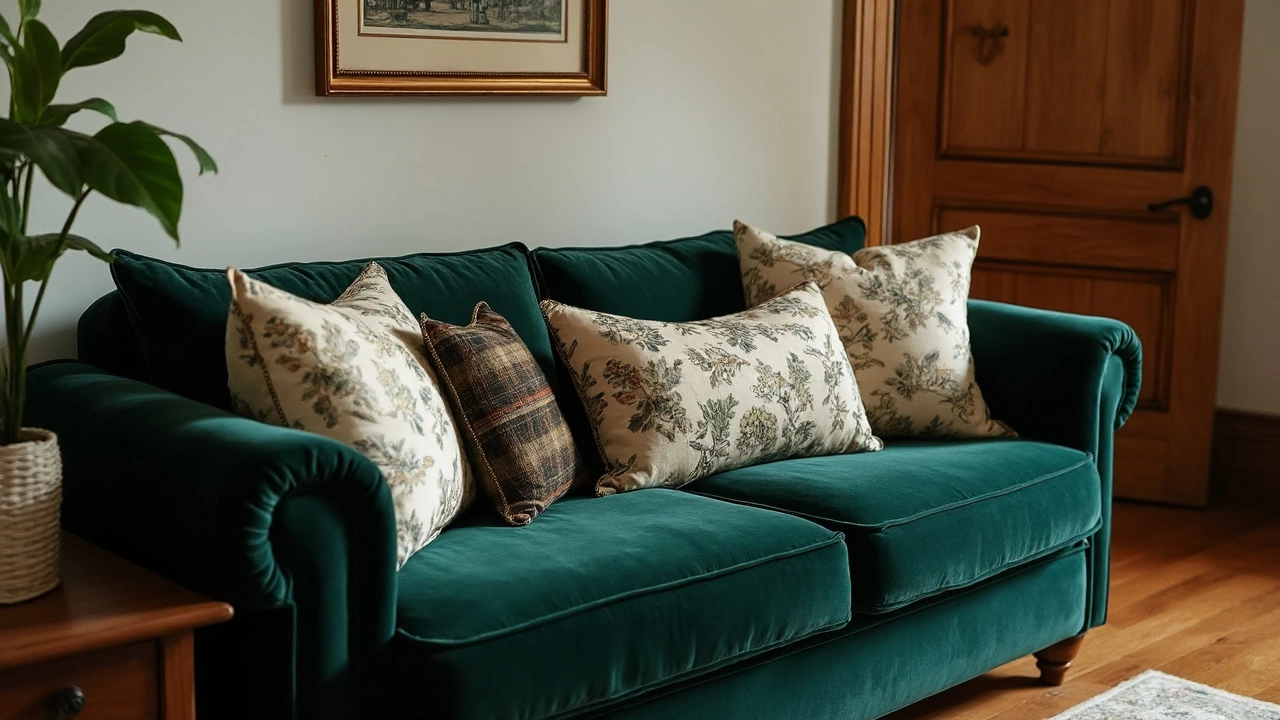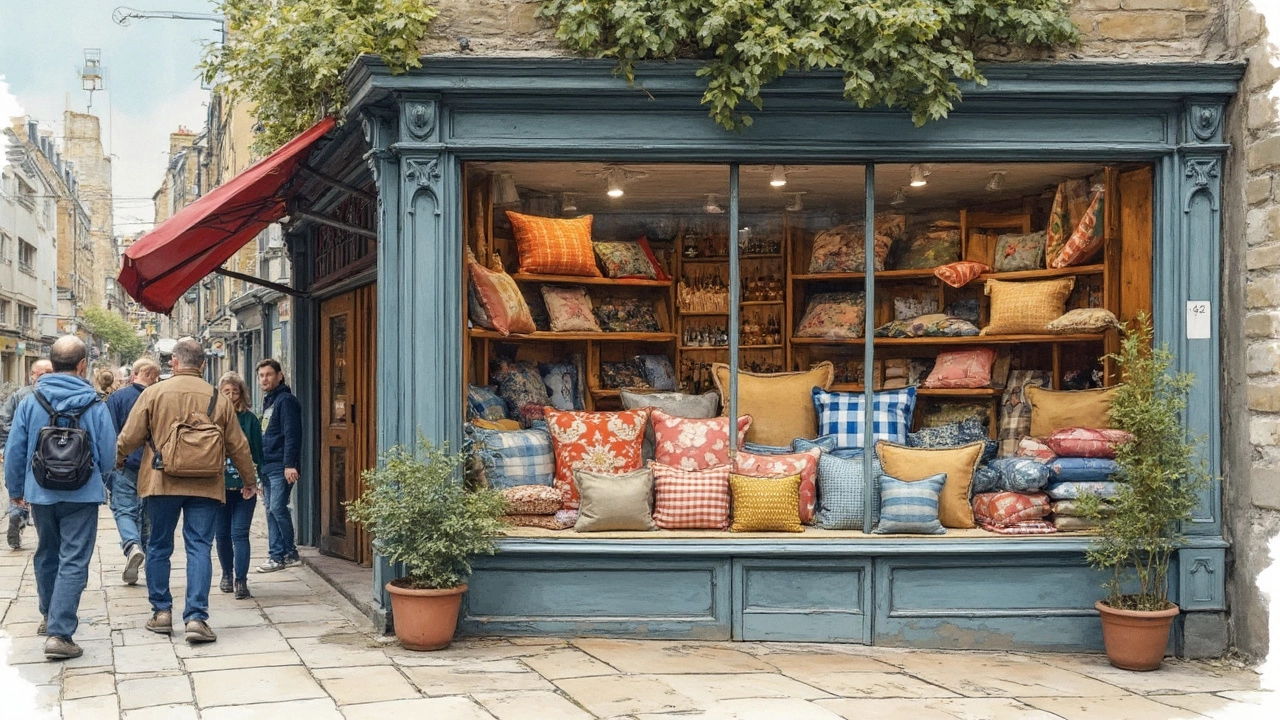Sofa Cushions: What Are They Really Called?
 Mar, 22 2025
Mar, 22 2025
So, you've probably spent a good chunk of time lounging on your sofa, but have you ever stopped to think about the cushion you're actually sitting on? Turns out, they have a specific name and purpose! The cushions on your sofa where you sit are technically known as 'seat cushions.' Plain and simple, right?
Seat cushions are more than just a place to rest your backside. They're key to your comfort and even the style of your living space. Without them, your sofa is basically just a frame. Ever tried sitting on a bare sofa frame? Not comfy. These cushions come in all shapes, sizes, and fillings to suit different needs.
Understanding the difference between seat cushions and those decorative pillows you might toss around is important. One is all about function—giving you a comfy spot to sit—while the other is more about form, adding a splash of style or a pop of color. Now, let’s dig a little deeper into the world of sofa cushions.
- Understanding Sofa Cushions
- Types of Sofa Cushions
- Choosing the Right Cushion
- Care and Maintenance Tips
Understanding Sofa Cushions
When you dive into the world of sofas, it's easy to get lost in all the choices. But understanding the sofa cushions—or more specifically, the seat cushions—can make this journey much smoother. The seat cushion is the heart of your couch experience, focusing on how comfortable and supportive your lounging adventure will be.
Let's break down what usually makes up these cushy wonders. Generally, they're constructed from foam, feathers, or fiber fills. Foam-filled cushions are all about offering sturdy support, making them a favorite for those who prefer a firmer landing. Feathers, on the other hand, provide a plush, sink-in feeling but might require regular fluffing to maintain their charm. Fiber fills strike a balance, giving a soft feel while maintaining a good shape without too much maintenance.
Common Cushion Fillings
- Foam: Great for those who want structure and durability. Lasts longer and keeps its shape with minimum fuss.
- Feathers: Offers that luxurious, soft feel. Perfect if you’re going for comfort over form. Requires regular plumping.
- Fiber: Sits between foam and feathers in both feel and care needs. Ideal if you want easy upkeep without sacrificing comfort.
It's also worth noting the cushion covers. These days, they come in a plethora of fabrics like cotton, polyester, leather, and more. Choosing the right cover depends on your lifestyle. Got kids or pets? You might want something durable and easy to clean.
Believe it or not, cushion sizes and shapes matter too! Standard seat cushions are typically square or rectangular. But you might encounter chaise-style or corner-compatible designs if your sofa has those features.
| Type | Durability | Maintenance |
|---|---|---|
| Foam | High | Low |
| Feathers | Medium | High |
| Fiber | Medium | Medium |
Whether you’re sprucing up your living room or just curious, knowing your couch cushions elevates your sofa game. It's all about finding that perfect spot to sit back and relax!
Types of Sofa Cushions
When it comes to choosing the right sofa cushions, there's a dizzying array of types out there. Let's break down the basics to help you understand what you might need.
1. Foam Cushions
Foam cushions are probably the most common type you'll encounter. They offer firm support, great durability, and they bounce back into shape easily. They're perfect if you like a cushion with a bit of structure. However, the level of comfort can vary depending on foam density, so it's something to keep in mind.
2. Feather or Down Cushions
If you're after that sinking, plush feeling, feather or down cushions might be your match. These couch cushions are filled with soft feathers, often from ducks or geese. They're super comfy and great for lounging, but they do tend to lose shape quicker compared to foam. You'll need to plump them up regularly to maintain their look and feel.
3. Fiberfill Cushions
Fiberfill cushions are another popular choice, particularly for those who want comfort without using animal products. These are stuffed with synthetic fibers, offering a soft seat that's a bit more supportive than down. They're often considered a happy medium between foam and feather cushions.
4. Wrapped Cushions
The best of both worlds can be found with wrapped cushions. These are typically foam or a core wrapped in a layer of feathers or fiberfill. This gives you the structure and durability of foam with the soft, cozy appeal of feather or fiber. Wrapped cushions are becoming increasingly popular for their balanced comfort and longevity.
Here’s a quick look into the typical composition these cushions might entail:
| Type | Primary Material | Advantage |
|---|---|---|
| Foam | Polyurethane | Durability |
| Feather/Down | Duck/Geeese Feathers | Plushness |
| Fiberfill | Synthetic Fibers | Softness |
| Wrapped | Combination | Balance |
Making the right choice depends on what kind of feel you're after and how much maintenance you're willing to do. Whatever you pick, the right seat cushions can seriously elevate your sofa game!

Choosing the Right Cushion
Selecting the perfect seat cushions for your sofa can seem daunting, but don't worry! It's all about understanding your needs and a bit of personal preference.
Consider Your Sofa's Style
Your sofa design plays a big role in picking the right cushions. If your sofa is modern and sleek, you'll probably want slimmer, firmer cushions to match the style. A more traditional or cushy sofa often pairs better with thicker and softer options.
Think About Comfort
Comfort is key. Do you prefer a firm or soft cushion? Sofa cushions come with different fillings like foam, feather, or fiberfill, each offering a unique feel. Foam cushions tend to be firmer and keep their shape well, while feather cushions provide that sink-in comfort but might require regular fluffing.
Measure and Match Sizes
Be sure to get the right size! A cushion that's too big or too small will look odd and not fit properly, affecting comfort and aesthetics. Measure the seating area of your sofa to find the perfect fit. Most cushions fit standard-sized sofas, but always double-check.
Material Matters
The cushion cover material should align with your lifestyle. If you've got kids or pets, you might want a durable, easy-to-clean fabric. Options like leather, microfiber, and canvas are known for their durability and ease of cleaning. For those who enjoy luxury, velvet or silk can add a touch of elegance.
- Foam: Offers support, best for those who like firm cushions.
- Feather: Provides softness but may lose shape more quickly.
- Fiberfill: A mix of both, providing a balance between firm and soft.
Ultimately, the right couch cushions will balance comfort, style, and practicality. Don't be afraid to test them out—literally sit on them if you can. Your day-to-day comfort at home is worth the extra effort in choosing wisely.
Care and Maintenance Tips
Taking good care of your sofa cushions is essential if you want them to last and keep your couch looking fresh. A little effort can go a long way. Here are some practical tips to keep in mind.
1. Regular Cleaning
Dust and dirt are the enemies of any fabric, and seat cushions are no exception. Make it a habit to vacuum your cushions every couple of weeks. Use a soft brush attachment to avoid damaging the material. If your cushion covers are removable, check the care label and wash them according to the instructions. It makes a big difference!
2. Fluffing and Rotating
Fluffing helps keep your cushions in shape. Give them a good shake and squeeze every now and then. For cushions that get a lot of use, consider rotating them every month or so. This helps distribute wear and tear evenly, which keeps them in good condition longer.
3. Spot Cleaning
Accidents happen. When spills occur, don't panic. Quickly blot the stain with a clean cloth. Avoid rubbing, which can spread the stain. For tougher stains, a gentle fabric cleaner can be a lifesaver. Test any cleaner on an inconspicuous area first, though!
4. Sunlight and Placement
Direct sunlight can fade fabric, so try to place your sofa in an area that doesn't get much sun exposure. If that's unavoidable, consider investing in UV-protective window film or curtains. And remember, keep those couch cushions away from radiators or other heat sources that can cause the material to deteriorate.
5. Investing in Quality
It might be worth investing in high-quality, durable cushion materials if you're in the market for new ones. They might cost a bit more, but they usually require less maintenance and last longer, making them a smart choice in the long run.